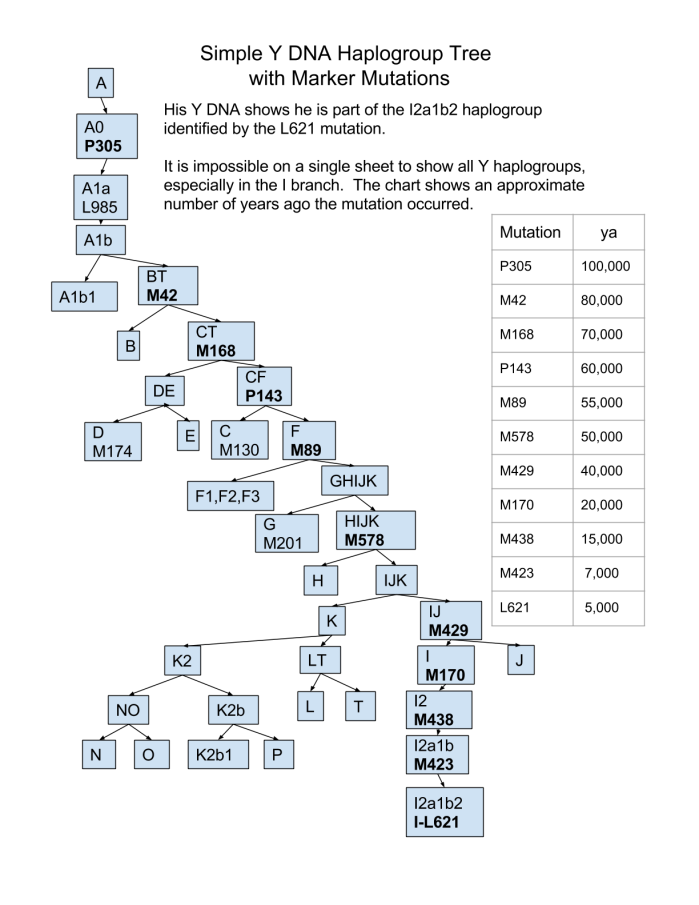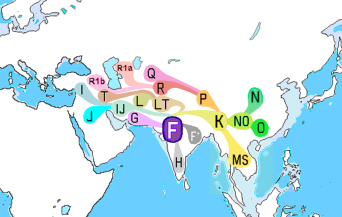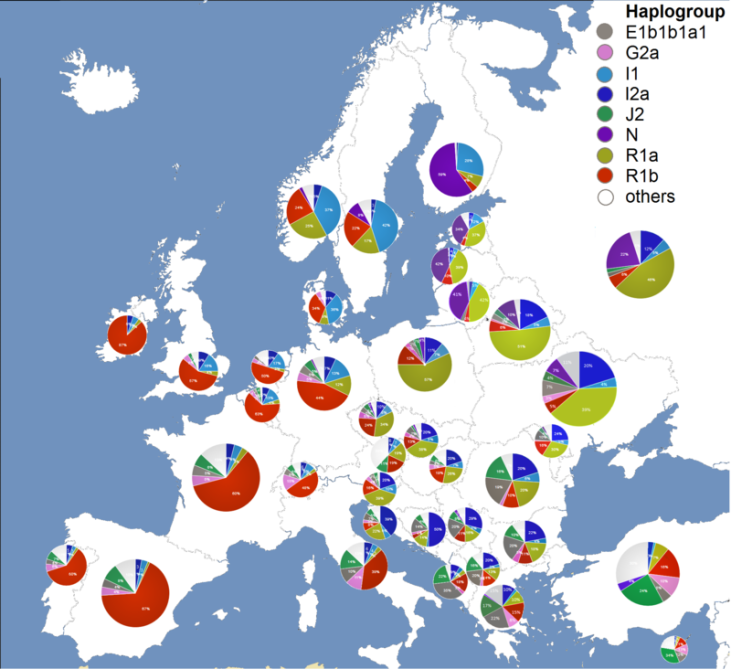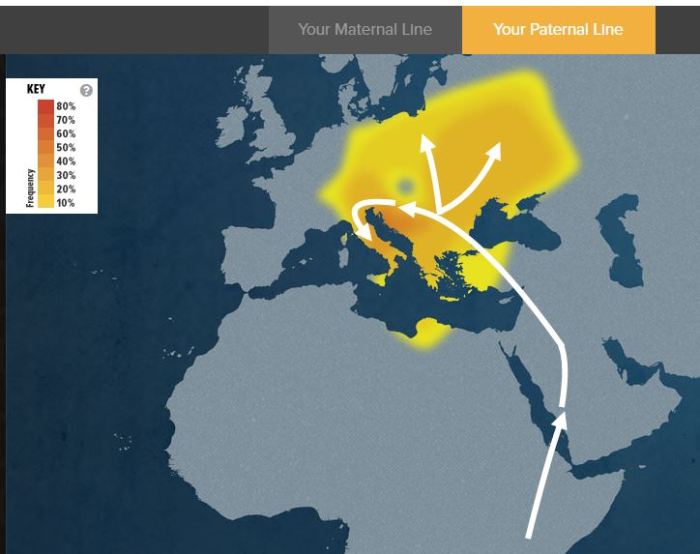If we follow His genetic mutations (changes to his Y-chromosome), His male ancestors are part of the I haplogroup. A haplogroup is a specific set of mutations documented in a line believed to have originated in one specific ancestor.

His haplogroup history is very interesting to us. Some are very expected and typical. Others are so expected to be unexpected.
P305 (A haplogroup) – This marker is believed to be an ancestor for 99.9% of all males currently living. This mutation is believed to have occurred about 100,000 years ago. Very few tribal males in Africa do not have this marker. It supports the theory that Homo sapiens branch began in Africa and migrated to other places after this mutation. (1)
M42 (BT haplogroup) – This mutation is believed to have occurred about 80,000 years ago. This marker is found everywhere in the world, leading scientists to believe this male ancestor’s descendants lead the way in leaving Africa. (2)
M168 (CT haplogroup) – This marker is found in all males living outside of Africa. This mutation is believed to have occurred about 70,000 years ago in East Africa. This branch of the Homo sapiens tree left Africa for the Middle East/Fertile Crescent region of the world. Why did they leave Africa? Million dollar question! Most likely to follow the food. (3)
P143 (CF haplogroup) – The CT haplogroup quickly formed the CF and DE haplogroups. CF branched about 70,000 years ago for form the C and F haplogroups. (3, 4)
M89 (F haplogroup) – This marker is extremely common (about 90%) in non-African populations, especially south and southeastern Asia. It is believed to have originated outside of Africa about 55,000 years ago. Here is a picture of its distribution. (3, 5)

M578 (HIJK haplogroup) – This mutation is believed to have occurred about 50,000 years ago. It is believed to be a branch off of the F haplogroup and is found in south and southwestern Asia. (6)
M429 (IJ haplogroup) – This mutation is also believed to have occurred in the southwestern Asia area and Middle East about 44,000 years ago. This haplogroup gives rise to the I haplogroup – the haplogroup found in Europe. (7)
M170 (I haplogroup) – The branch of the tree moved into Europe, probably as an ice age was ending and migration into that region was possible. This marker is believed to have occurred about 20,000 years ago in Europe or near the boundary with Asia. This is after the extinction of the Neanderthals so these ancestors must have interacted with them before this mutation occurred. This is a very common European haplogroup with high concentrations in northern Europe and southwest Europe. The I haplogroup (as blue and purple in the image) are found in different concentrations, leading scientists to believe there were waves of migration into Europe. (8)
His male ancestors were from the island of Brac in Croatia. An article by Barac et al discusses the Y chromosome inheritance on this specific island. This area of the world has the highest frequency (49%) reported in Europe. His Y chromosome markers from 20,000 years ago support this! This area has been inhabited since the middle Palaeolithic time period (100,000 – 40,000 years ago), overlapping with Neanderthals. (9)

M438 (I2 haplogroup) – The highest frequency of this marker is found in Bosnia and Herzegovina (located close to the island of Brac) It is believed to have originated about 15,000 years ago. (10)
M423 (I2a1b haplogroup) – This marker is found in southeastern Europe and western Asia. It is commonly found in Croatia, Bosnia and Herzegovina, and Serbia. It is found in the rest of Europe less than 1%.

L621 (I2a1b2 haplogroup) – This is a south Slavic marker found in the highest frequency in Croatia and Bosnia and Herzegovina. (10, 11)
So I guess this means He is actually of Croatian descent and His ancestors lived in this area for MANY years!
Sources:
I was unable to link to the information found in The Genographic Project by National Geographic. Much of the information came from there.
(1) https://en.wikipedia.org/wiki/Haplogroup_A_(Y-DNA)(2) https://en.wikipedia.org/wiki/Haplogroup_BT
(3) https://en.wikipedia.org/wiki/Haplogroup_CT
(4) https://en.wikipedia.org/wiki/Haplogroup_CF_(Y-DNA)
(5) https://en.wikipedia.org/wiki/Haplogroup_F-M89
(6) https://en.wikipedia.org/wiki/Haplogroup_HIJK
(7) https://en.wikipedia.org/wiki/Haplogroup_IJ
(8) https://en.wikipedia.org/wiki/Haplogroup_I-M170
(9) Barac, Lovorka et al. (2003) Y Chromosome heritage of Croatian population and its island isolates. European Journal of Human Genetics. 11, 535-542
(10) https://en.wikipedia.org/wiki/Haplogroup_I-M438
(11) http://www.eupedia.com/europe/Haplogroup_I2_Y-DNA.shtml#I2a1b
I don’t understand with a European Paternal Haplogroup. Some European Men belongs to Haplogroup R, R1a, R1b, but some European Men (Eastern Europe, Scandinavian, Denmark, Northwest Russian, Finns) belongs to Haplogroup I, Y DNA Hg J’s Cousin’s. I think a Y DNA Hg I-M170 are quite different with European Hg R, R1a and R1b. But, i’m not too surprise when in European Men also have Y DNA Haplogroups E1b1b, J1, J2 and N3. Maybe they’re just a newcomer’s.
BUT,
A European and a Middle Eastern have similar Maternal Haplogroups, an mtDNA Hg N, N1, I, X , W, R (HV, H, V, JT, J, T, U and K). H is more common in Europe and J is more common in Middle East.
LikeLiked by 1 person